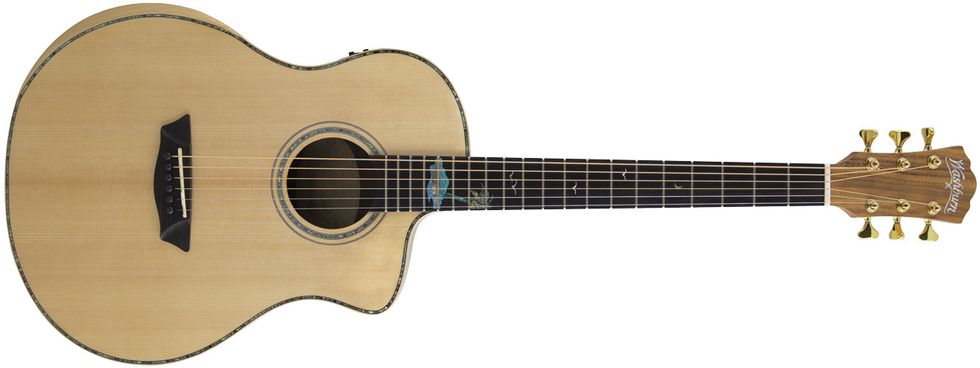RatingsPros:Balanced sound. Excellent playability. Lots of practical features for the price. Cons: Island-themed inlays won’t be everyone’s mug of mai tai. Street: $449 Washburn Bella Tono Allure SC56S washburnguitars.com | Tones: Playability: Build/Design: Value: |
Computer-aided design, diversified tonewood sourcing, and modernized overseas manufacturing started dramatically impacting the quality of affordable guitars years ago. But these days, the refinements that made inexpensive, high-quality guitars possible make inexpensive fancy guitars a reality too. The Bella Tono Allure SC56S by Washburn is an excellent example. At about $450, it’s well within the “affordable” spectrum. But with features like a forearm bevel, maple binding, and fancy abalone inlay, it also offers amenities associated with guitars several notches up the price ladder—and a balanced, versatile voice, too.
Beach Trip
Each Bella Tono model features Washburn’s new “studio” body, which is approximately the size of an orchestra- or auditorium-size body. But it’s the features more than the comfortable dimensions that strike you first. The fretboard’s abalone and turquoise inlays depict a tropical scene, complete with a palm tree that starts around the 12th fret, and above it, seagulls in flight. The top and rosette sport abalone purfling. And where you often see plastic binding on a guitar in this price class, the Allure’s is maple. The solid spruce top has a warm, reddish hue and subtle popcorn-like figuring, and the acacia-laminate back and sides are also nicely figured. The attractive package is rounded out with gold die-cast tuning machines—which, incidentally, are very smooth and stable.
Overall, the Allure is very well built. The body’s gloss finish is free of imperfections, and the setup is carefully executed. Some small anomalies are apparent upon close inspection: a little debris from the manufacturing process inside the guitar, a corner of the bridge that could have been better sanded, and a hint of sharpness at the fret ends. These are not irregularities you would want to see in a new high-end guitar, but they don’t significantly affect playability on the Allure and are easier to overlook at this price, if not downright commonplace.
Nice and Even
Between the Washburn’s compact body dimensions and forearm bevel, the guitar is super-comfortable to hold. The C-shaped neck, with satin finish and low action, feels fast, effortless, and inviting to play, too. The dramatic cutaway makes it possible to reach even the very highest frets with ease. And in general terms of playability, the Allure is the kind of acoustic that both electric and acoustic-first players would find familiar and welcoming.
The Allure’s basic voice is pleasing, with firm but not overpowering bass notes, present midrange, and pretty, rounded trebles. Up and down the neck, individual notes sound out consistently and the excellent intonation gives melodic runs an attractive chiming quality. Yet while the Allure features the relatively compact dimensions of a fingerstyle instrument, it doesn’t strongly favor any particular approach or technique. It doesn’t sound compressed or overwhelmed when played with a pick, but still sounds lively when played fingerstyle. You won’t get dreadnought-level bottom end, obviously. And players who live more decisively in, say, the strumming-dreadnought or fingerpicking-OM camps may long for more personality from one side of the spectrum or the other. But what the Allure might lack in low-end punch it often makes up for in balance. And for a beginning guitarist seeking a voice that suits their developing style, or a performer who moves across genres, the Allure is a great neutral platform for those explorations.
Like many affordable guitars these days, the Allure is outfitted with electronics. In this case, it’s Barcus Berry’s LX4, which includes an under-saddle pickup and a preamp with volume, bass, middle, treble, and presence controls. There’s also a built-in tuner. The system is powered by a 9V battery, which is accessible via a pop-out enclosure on the lower bass bout.
Plugged into a Fender Acoustasonic amp with the controls set flat, the Allure and Barcus Berry tandem are noise free, reasonably lifelike, and well suited to the guitar’s relatively neutral voice. It’s also comparatively resistant to feedback.
The Verdict
Back in the late 1980s, I bought what you might call a “solidly okay” imported steel-string for $800 (about $1,700 in 2019 dollars). That guitar didn’t have the best playability or sound, but it was handy to have around for a while. Washburn’s Allure SC56S, which would cost slightly over $200 in late-’80s bucks, would have destroyed the budget acoustic I bought back then. And while the bling won’t suit everyone’s taste (more subdued variations of the Bella Tono shape are available), the Allure’s adaptability, comfort and playability, and breadth of voices make it a remarkable guitar for the money.






















